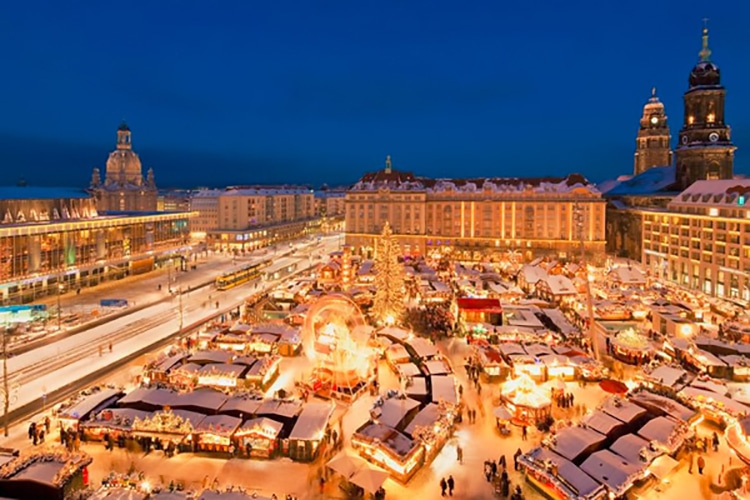My nose led me to the oven, heavenly aromas wafting from behind its doors. Something delicious was baking and I had to have a taste. I was in Dresden at the Striezelmarkt, the city’s Christmas market, and it was Stollen, a rich buttery cake with dried fruit, nuts and spices, turning golden inside the outdoor oven. Master Baker Joachim Winkler was rolling another batch of dough as spectators watched the creation of Dresden’s famous holiday cake. Best of all, there were free samples.
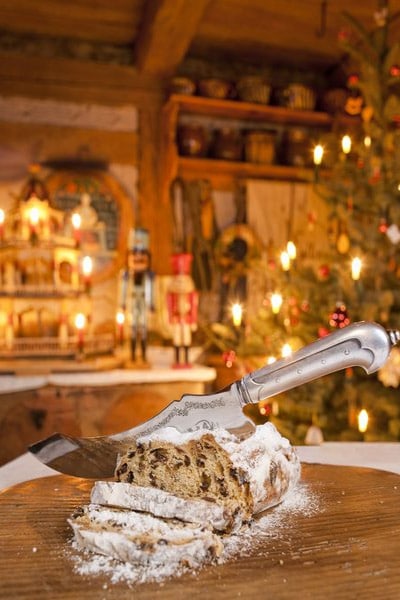
That was many years ago. I lived in Germany then and sought out holiday markets every December. Major cities, like Dresden, usually have them in various locations. However, Christmas markets in smaller towns, while perhaps not as grand, are equally enticing. I enjoyed them all. The tradition of pre-Christmas markets originated in Germany as trade fairs in the late Middle Ages. These days the custom has spread throughout the world with Christmas markets on the calendar in numerous countries. But, Germany has the best.
I especially miss going to the markets late day. In December when dark descends they are captivating scenes with twinkling lights sparkling on tinsel and gilded ornaments. If snow falls, it’s enchanting. People wrapped in heavy winter coats and woolen scarves pack the market square to eye the merchandise displayed at stalls decorated with swaths of fir and pine. Everything from holiday decorations to handicrafts, from mittens to furry slippers, is for sale. And, in addition to Stollen, other delicious treats stir the appetite: grilled sausages and spicy cookies washed down with a nip of Glühwein or “glowing wine,” a mulled wine served hot. “A Christmas market without Glühwein, there is no such thing,” says my German friend Ortrud. Traditionally made with red wine, today you can find white varieties, as well as versions with liqueurs for an extra kick. It is usually served in souvenir mugs which you can purchase.
Food is my favorite part of Christmas markets. Be it in Stuttgart, which is one of Germany’s largest markets, or Nuremberg, possibly the most romantic, or Dresden or any small town, there’s nothing quite like warming up in winter with a little Glühwein and savoring a grilled bratwurst as church bells toll and children sing carols. Move on to another stand for more Glühwein and a healthy portion of Schupfnudeln (potato dumplings with sauerkraut) or a Linseneintopf (a thick soup of lentils) and Kartoffelpuffer (potato pancakes). It’s a unique and thoroughly German culinary experience that is scrumptious.
Christmas markets are just one of many holiday traditions in Germany and with Stollen and holiday cookies topping the to-eat list, Germans tend to begin their holiday baking in late November. While everyone, not just Dresden’s residents, indulges in that luscious cake, fewer are making it at home these days. It’s time consuming, and, as Ortrud says, the ones you can buy at the bakery are just as good.
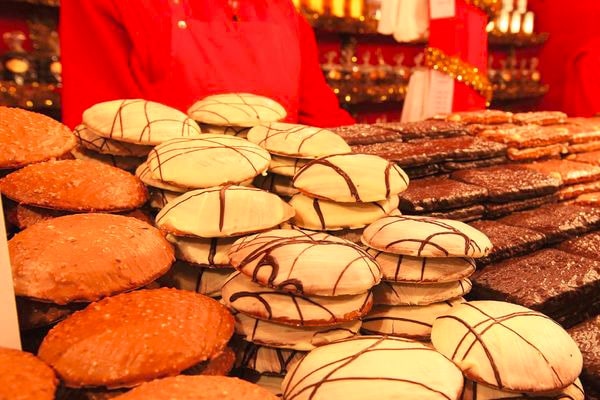
Cookies are another matter, however, and we’re not referring to a few chocolate chip and oatmeal cookies. Most Germans typically bake about eight different kinds of cookies. Ortrud, who admits she overdoes it, makes about 15 varieties! Lebkuchen are a must. These dark, spicy cookies which originated in Nuremberg 600 years ago are made with seven different spices. Holiday cookies are consumed throughout Advent, the pre-Christmas season that begins on the fourth Sunday before Christmas day, this year on November 29.
In addition to the delectable foods and Glühwein, there are other beverages associated with the season. Feurerzangenbowle, a flaming punch, often appears at Advent gatherings. A pure sugar cone soaked in rum is set aflame over a punch bowl of spiced red wine. The melted sugar and rum drip into the wine for a concoction guaranteed to warm the spirits. Of course, the Germans also have a special Christmas beer, Weihnachtsbier, a strong brew for December’s shorter days and chilly temperatures which makes its appearance at the beginning of Advent.
Almost every home has an Advent wreath of greens with four candles often placed in the center of the dining table. On each of four Sundays leading up to Christmas, one of the candles is lit, so that by Christmas all four are burning. The lighting ceremony is usually part of a Sunday afternoon coffee and cake ritual – a tradition with or without candles – which many Germans practice year round. During Advent in many homes it’s an occasion to sing Christmas carols.
Advent calendars are popular with children. The original ones had little windows, one for each day before Christmas, with Biblical motifs behind them. A new window was opened each day counting down to Christmas day. Today, little bits of chocolate can be found behind the windows replacing the religious scenes. December 6, Saint Nicholas Day, is a big event for German children. On the night before, they put a shoe or hang a stocking in front of their doors. If they’ve been good, the next morning it will be filled with fruits, candy and small gifts from Saint Nicholas. But, the legendary saint doesn’t make his trek from house to house alone. Knecht Ruprecht, a sinister figure who strikes terror in any mischievous child, accompanies him. He puts a twig or piece of coal in the shoes or stockings of naughty children.
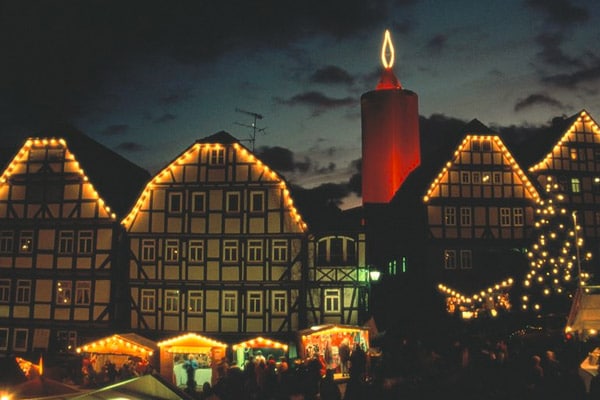
The Alsatians take credit for the first Christmas tree, traced back to the 17th century, and the tradition quickly spread to neighboring Germany. In the not too distant past, many Germans decorated their tree with real candles, usually of beeswax. The scent of the melting wax and fresh pine is heavenly and the soft, flickering glow beats anything provided by electric lights. I went native for my first Christmas in Germany long ago and decorated with real candles, lit only on Christmas Eve. I kept a pail of water by the tree and monitored it while the candles burned. It was magical but it is risky. As Ortrud says, “Too many trees have burned. We have electric lights now.” Perhaps no more real candles, but definitely real trees. Germans are not into anything artificial. The Nuremberg angel, Rauschgoldenengel, which can be found at Christmas markets throughout the country, often crowns the tree. Exquisite angel dolls usually have long flowing blond hair and are dressed in gowns of velvet, satin or gilded paper. According to legend, the doll was created by a heartbroken toymaker after an angel who looked like his deceased daughter appeared to him in a dream. There is a giant version that -hovers over the entrance to the Nuremberg Christmas market.
In addition to the tree, other traditional decorations are often found in German homes. The pyramid, a tall rotating candelabrum, is a favorite. Hand-carved wooden figures on multi levels are interspersed with candles. When lit, the heat sets the various levels turning, its figures spinning round and round. Towering over the market in Dresden, in addition to a giant Christmas tree, is a gargantuan pyramid — but illuminated with electric lights.
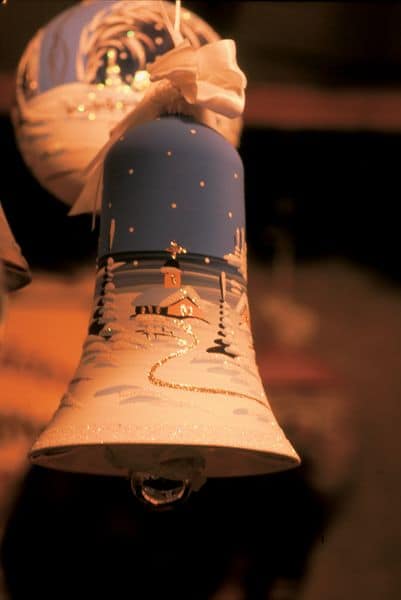
Woodcarvers in the Erzgebirge (Ore Mountains) region make the mobile decorations, as well as other beautiful hand-carved items such as smokers (figures that blow smoke from incense cubes) and nutcrackers, which are famous throughout Germany. All of these objects are also for sale at Christmas markets.
Christmas Eve dinner is special and varies within the different regions. Carp is a favorite in many places. In Hamburg, it’s usually herring salad with fried potatoes, while in the Rhineland they dine on sausages and potato salad. Most Germans go to church, either before or after dinner, and open presents on this special night. Come Christmas Day, in all parts of the country, many sit down to a dinner of roast goose. But, that too is changing, with turkey replacing goose in many homes and as Christmas falls during hunting season, some enjoy wild boar or venison.
The entire holiday season in Germany, from the beginning of Advent to the Feast of the Epiphany, Jan. 6, the official end of the season when most Germans take down their tree, is full of enchantment, excitement and joy. From spicy cookies and “glowing” wine to festive markets, it is a living “old fashioned Christmas” from the pages of storybooks. According to an old saying, “Germany without Christmas wouldn’t be Germany.” I might add, “You haven’t experienced a real Christmas until you have experienced a German Christmas.
Highlights of the Markets
The holiday season officially gets underway on the first Sunday of Advent, Nov. 29, but many Christmas markets are open for business earlier. Most close on Christmas Eve. Many feature more than stands selling all sorts of merchandise and edible treats. Bands, concerts, puppet shows, parades, craft demonstrations and more are additional enhancements to the festive
Highlights of the Markets
The holiday season officially gets underway on the first Sunday of Advent, Nov. 29, but many Christmas markets are open for business earlier. And, many feature more than stands selling all sorts of merchandise and edible treats. Bands, concerts, puppet shows, parades, craft demonstrations and more are additional enhancements to the festive markets. Don’t neglect the small towns. While many of their markets are only open on weekends, they’re usually less crowded, and equally enchanting.
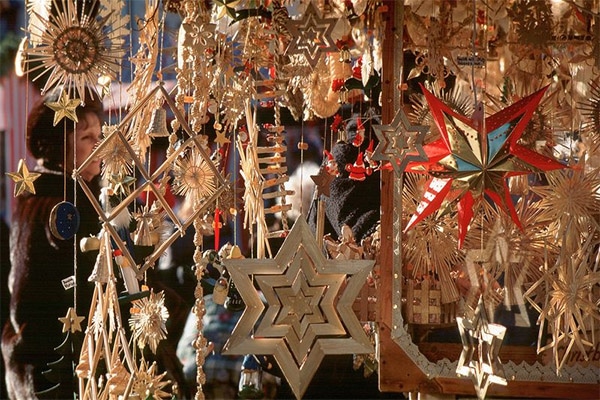
The market in Nuremberg, considered the most romantic, is the country’s most famous. It is called the Christkindlesmarkt, or Christ child market. During the time of Martin Luther, children received their gifts (not just small gifts as is the common practice today) on December 6th, St. Nicolas Day. Luther, however, was not a fan of venerating saints and saint’s days, so he started the practice of giving gifts on Christmas Eve, telling his children that the gifts came from “Holy Christ.” This custom became popular with Lutheran families, and then spread to others.
At the market you’ll find the city’s tasty cookies, Lebkuchen, in every size and with different icings like chocolate, sugar or even strawberry. They are also sold in beautiful tin boxes. Another Nuremberg special now also found at many other markets is Zwetschgenmännlein (prune men), elfin figures made of dried prunes, figs and nuts. The Christkindlesmarkt is open from Nov. 27 to Dec. 24.
Dresden, where Stollen originated, hosted its first Christmas market in 1434, with its name, Striezelmarkt, referring to Stollen. “Striezel” is a Middle High German word for the cake, and also refers to the long, oval shape of the pastry which it’s said symbolizes the infant Jesus in swaddling clothes. Packages of original Dresdener Stollen even bear an official seal. Numerous market stands, as well as bakeries in the city, do a booming business with the tasty cake. The giant wooden pyramid towering over the market, listed in the Guinness Book of Records, is 45-feet tall with carved figures on its multi-levels. The market is open from Nov. 26 to Dec. 24.
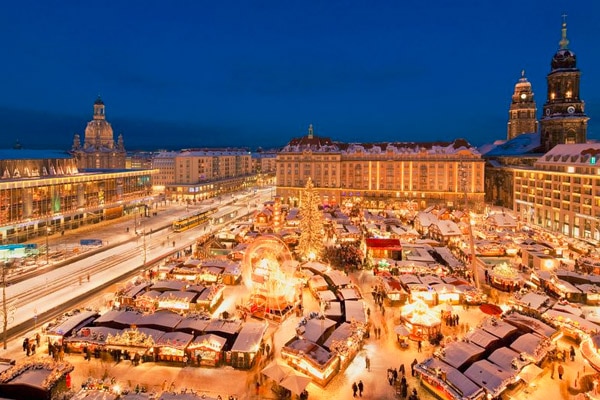
Berlin, Germany’s largest city, tops the list with the most Christmas markets – 60 in all. Near the Potsdamer Platz market is an ice skating rink as well as the Winter World with a toboggan run. The markets are open from Nov. 23 to Dec. 27.
Originating in 1393, Frankfurt’s market is the oldest of Germany’s Christmas markets and one of the most beautiful with its historic Römer, Town Hall, as the backdrop for numerous festive stalls. Musical events are scheduled throughout the market, including trumpet players on the balcony of St. Nikolai church. Frankfurt’s market is scheduled from Nov. 23 to Dec. 22.
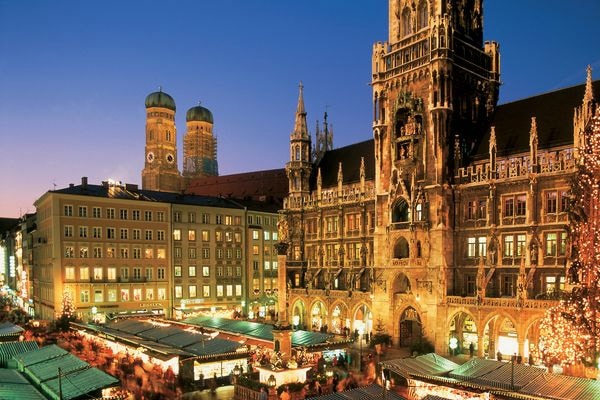
In Munich, the main Christmas market is at the Marienplatz with its historic town hall. Concerts from the building’s balcony are a favorite, and Bavarian products are a market specialty: wood carvings from Oberammergau, glassware from the Bavarian Forest, Lebkuchen from Nuremberg and more. Munich’s market is open from Nov. 25 to Dec. 24.
For a complete listing of Germany’s Christmas markets visit www.germany.travel/christmas.

